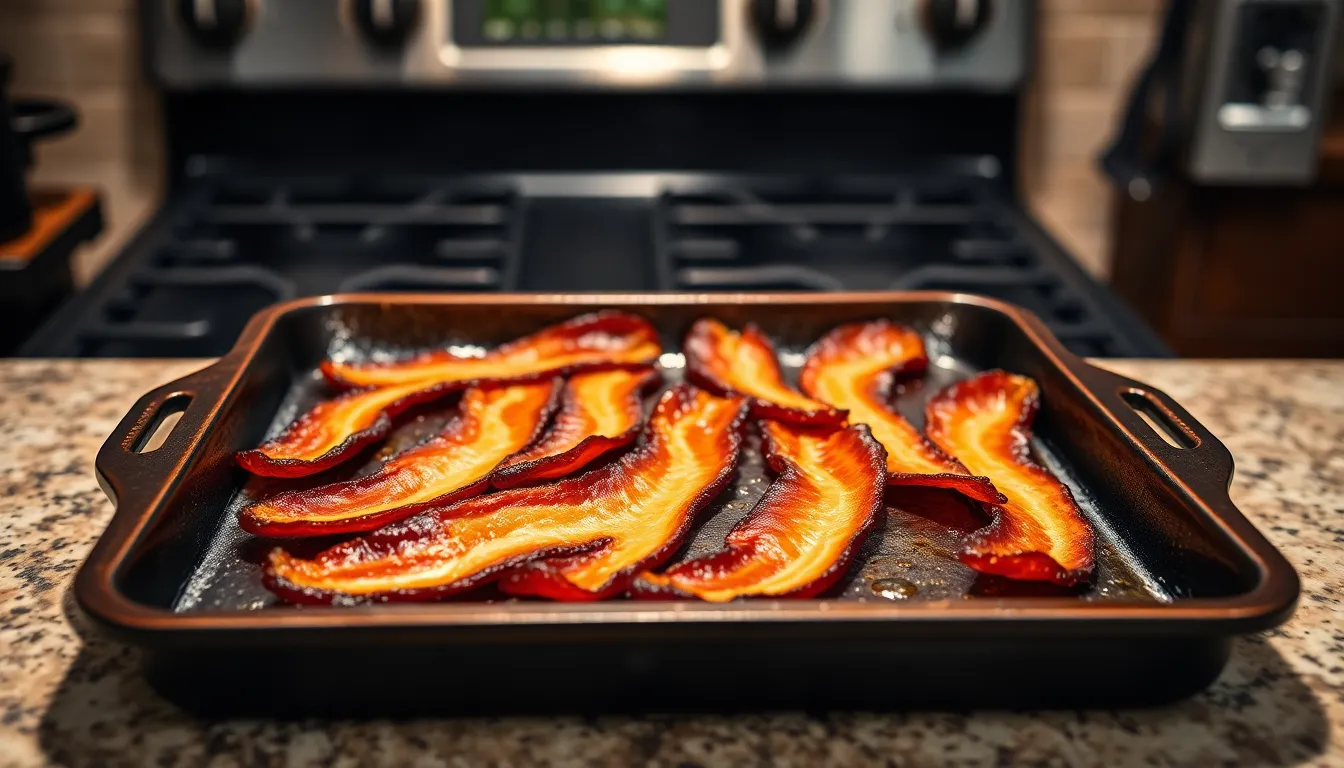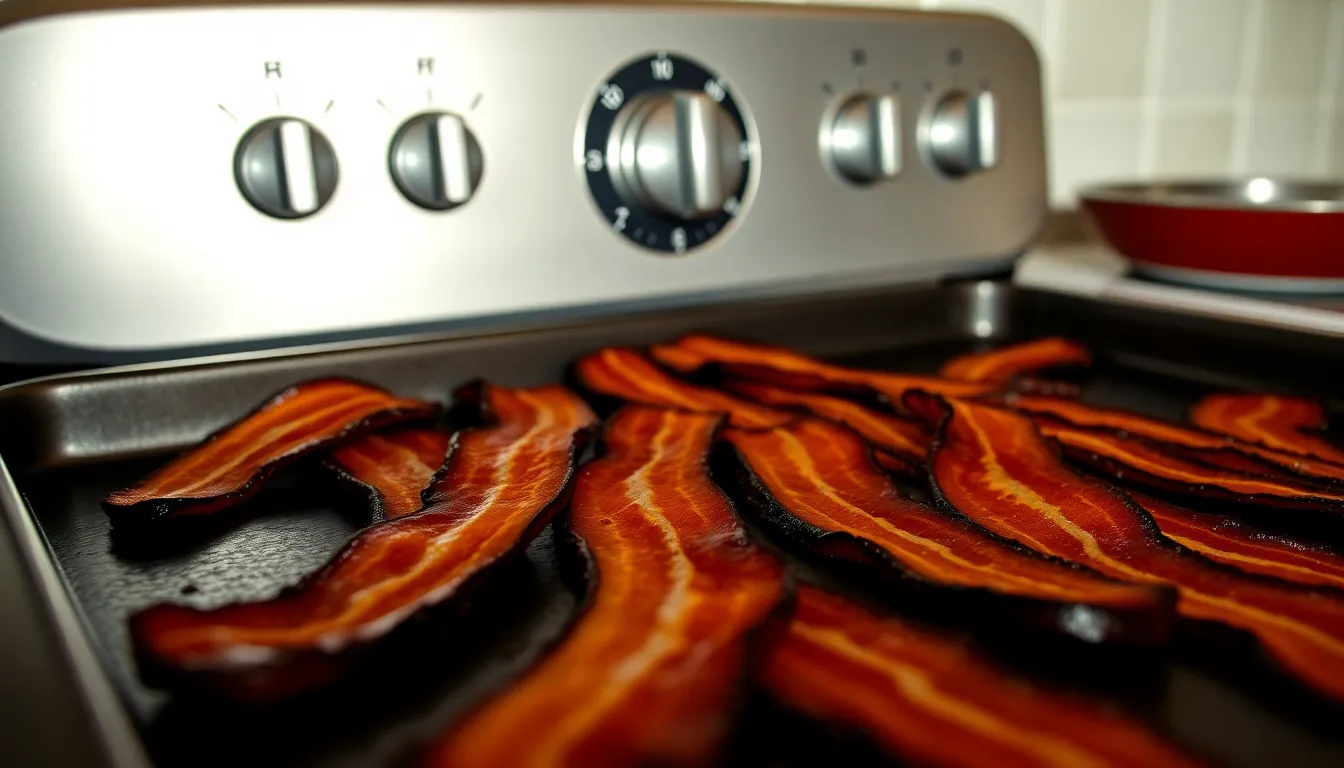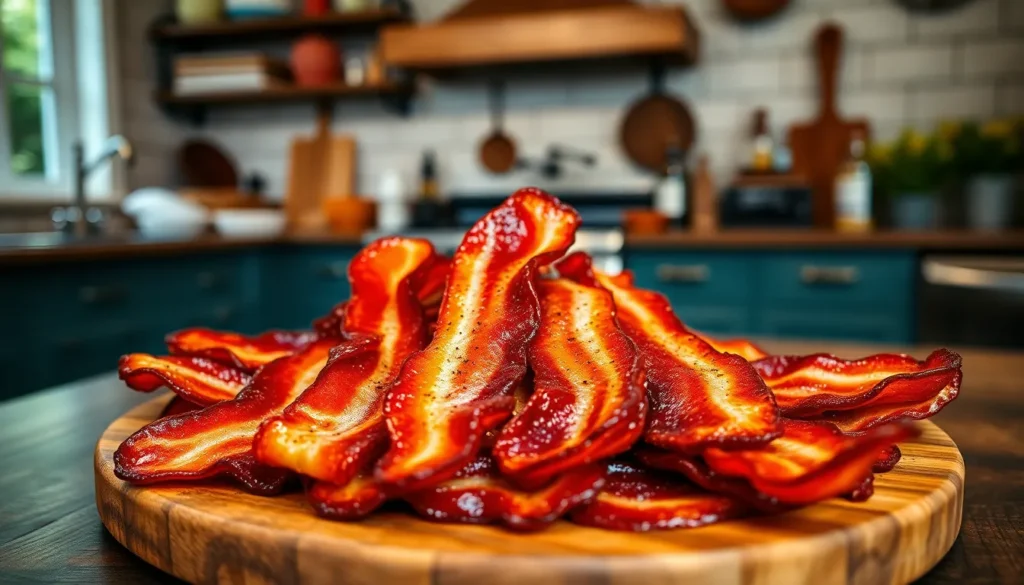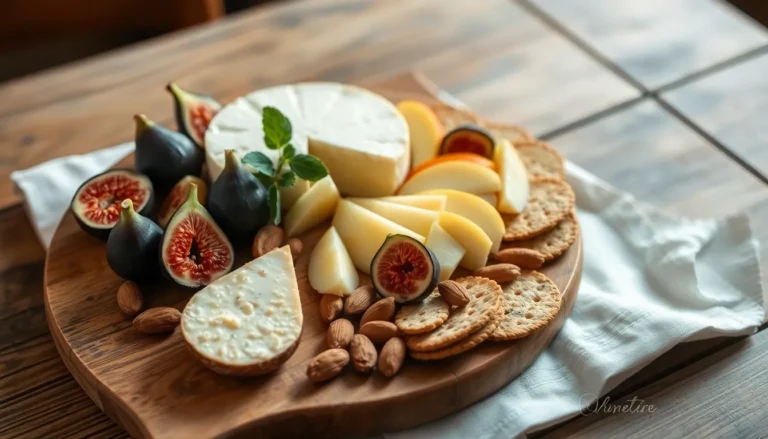Bacon lovers unite! There’s nothing quite like the sizzle of crispy bacon filling the kitchen. But before you dive headfirst into this savory delight, you might wonder: what’s the best temperature to bake bacon? Spoiler alert: it’s not just a guess; it’s a science.
Table of Contents
ToggleUnderstanding Bacon Textures
Bacon textures vary significantly based on cooking methods and temperatures. Knowing these differences helps in achieving preferred results.
Crispy vs. Chewy Bacon
Crispy bacon features a brittle texture, ideal for crunch enthusiasts. Chewy bacon provides a softer, more tender experience, favored by those who enjoy a little bite. Adjusting the baking temperature directly impacts the texture. Higher temperatures lead to crispiness, while lower temperatures maintain chewiness. A range of 375°F to 400°F often yields crispy results, while temperatures below 350°F encourage a chewier texture. Taste comes down to personal preference, so experimenting with different temperatures can help find the perfect balance.
The Science Behind Bacon Fat
Bacon fat contributes significantly to flavor and texture during cooking. When heated, fat renders and transforms into a crispy exterior. This process creates a delicious layer, enhancing the overall taste. The Maillard reaction occurs, fostering browning and complex flavors. Maintaining the right temperature is crucial for optimal fat rendering. Too low of a temperature leads to uneven cooking, while excessive heat can burn the bacon. Understanding how fat behaves during the cooking process clarifies how it impacts bacon’s final texture. Adjusting the baking temperature accordingly allows for better control over the outcome.
What Temperature to Bake Bacon


Baking bacon requires attention to detail, especially when it comes to temperature. Finding the right setting enhances texture and flavor.
Recommended Baking Temperatures
Optimal baking temperatures for bacon typically range from 375°F to 400°F. Cooking at these levels promotes crispiness by rendering fat effectively. Some prefer lower temperatures, like 325°F, for a chewier texture. Adjusting temperatures can cater to personal preferences, making bacon crispy or chewy as desired. Experimentation at various temperatures helps to achieve the perfect result.
Impact of Different Temperatures on Cooking Time
Cooking time for bacon varies significantly based on temperature settings. At 400°F, bacon cooks in 15 to 20 minutes, transforming into a crispy delight. Lower temperatures, such as 325°F, extend cooking time to 20 to 25 minutes while allowing for better control of chewiness. Understanding the correlation between temperature and cooking time is crucial for achieving the desired bacon texture.
Preparing Bacon for Baking
Preparing bacon for baking requires careful selection and seasoning for optimal flavor.
Choosing the Right Bacon
Bacon varieties greatly influence the final outcome. Traditional pork bacon is popular for its rich flavor, while turkey bacon offers a leaner alternative. Thick-cut bacon provides a meatier texture, ideal for those who prefer a satisfying bite. He or she should consider the quality of the bacon as well; nitrate-free and high-quality brands can enhance taste. Different cuts like slab bacon allow for customization in thickness. Ultimately, selecting the right bacon contributes significantly to the overall baking experience.
Seasoning and Flavor Enhancements
Seasoning bacon can elevate its flavor profile dramatically. A simple sprinkle of black pepper adds depth, while maple syrup or brown sugar introduces a sweet contrast. Alternatively, spices like paprika add a smokiness that complements the natural flavor of the bacon. If someone enjoys a bit of heat, a dash of cayenne pepper works wonders. Marinades can infuse even more flavor; for example, a quick soak in Worcestershire sauce creates a savory kick. Experimenting with these enhancements allows for personalized bacon creations, perfectly tailored to individual tastes.
Baking Tips and Techniques
Baking bacon effectively requires attention to detail. Proper bakeware and awareness of common mistakes enhance the final product.
Using the Right Bakeware
The choice of bakeware significantly impacts bacon’s texture. Use a rimmed baking sheet to catch rendering fat and prevent mess. Parchment paper can also simplify cleanup and prevent sticking during the baking process. Baking racks, positioned on top of the baking sheet, promote even cooking by allowing hot air to circulate around the bacon. Various materials like stainless steel or non-stick pans offer unique benefits; stainless steel withstands high temperatures, while non-stick models facilitate easier release.
Avoiding Common Mistakes
Many errors can affect bacon quality during baking. Overcrowding the pan restricts airflow and leads to uneven cooking, making it crucial to space the bacon strips apart. Not preheating the oven can result in longer cooking times and inconsistent texture. Ignoring cooking times at varying temperatures often compromises desired doneness. It’s essential to monitor bacon and adjust based on visual cues. Regularly checking prevents burning and helps achieve the perfect crispness.
Healthy Baking Alternatives
Exploring healthier baking alternatives can enhance the bacon experience without sacrificing flavor. Many options exist that reduce fat and calories while still delivering delicious results.
Using Lower-Fat Bacon Options
Choosing lower-fat bacon types, such as turkey bacon or center-cut bacon, can significantly cut calories and fat. Lower-fat varieties retain a good amount of flavor while offering a lighter option. Typically, turkey bacon contains about 60% less fat than traditional pork bacon. Moreover, it crisps up well in the oven, making it an excellent substitute for those seeking healthier choices.
Oven vs. Microwave Baking
Baking bacon in an oven ensures even cooking and enhanced texture compared to microwave methods. Ovens distribute heat uniformly, allowing fat to render evenly, leading to crispier results. Conversely, microwaving cooks bacon quickly but may result in uneven textures. Additionally, microwaved bacon often turns out chewier rather than crispy, which may not suit everyone’s preference. For optimal flavor and consistency, many choose the oven method over the microwave.





